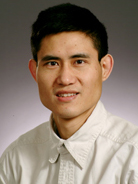Dapeng Wu, Ph.D.
Associate Professor of Electrical and Computer Engineering
College of Engineering
2009 Awardee
 Dapeng Wu has published extensively in the areas of networking, signal processing, computer vision, and machine learning. His significant work includes effective capacity and ripplet transform. The importance of effective capacity lies in the fact that it provides a tool previously not available for wireless network designers, and fills the gap between networking and physical layer design. The ripplet transform holds great potential to improve the performance of current image/video coding algorithms. Wu’s research may result in progress in image/video coding, which is widely used in cell phones, Internet multimedia players, digital TV sets, digital cameras, digital camcorders, and satellite TV.
Dapeng Wu has published extensively in the areas of networking, signal processing, computer vision, and machine learning. His significant work includes effective capacity and ripplet transform. The importance of effective capacity lies in the fact that it provides a tool previously not available for wireless network designers, and fills the gap between networking and physical layer design. The ripplet transform holds great potential to improve the performance of current image/video coding algorithms. Wu’s research may result in progress in image/video coding, which is widely used in cell phones, Internet multimedia players, digital TV sets, digital cameras, digital camcorders, and satellite TV. Wu uses biology to study computer worms in mobile networks. Since the birth of computer worms, our understanding of them has drawn an analogy to biological epidemics. A critical aspect of network security research is a description of the contact network through which the epidemic spreads. Wu studies the behavior of contact-based epidemics and proposes a randomized complexity-theoretic view of such epidemics. By leveraging the knowledge in biological epidemics, he will develop a formal model to explain the outbreak behavior of worms in mobile networks. The result from this research is expected to push the frontier of the area of bio-inspired network security.
Wu uses network security and complexity theory to study biological cyanide poisoning. He draws an analogy between biological cyanide poisoning and security attacks in self-organizing mobile ad hoc networks. This new analytic approach leads to a new view of biological threats from the perspective of network security and complexity theory. Since the existing biology has limited success in explaining whole-organism-level structures, functions, and behaviors due to the sheer complexity of a whole organism (e.g., trillions of cells in a human body), his research is expected to provide a critical tool in understanding structures, functions, and behaviors at the whole organism level.

